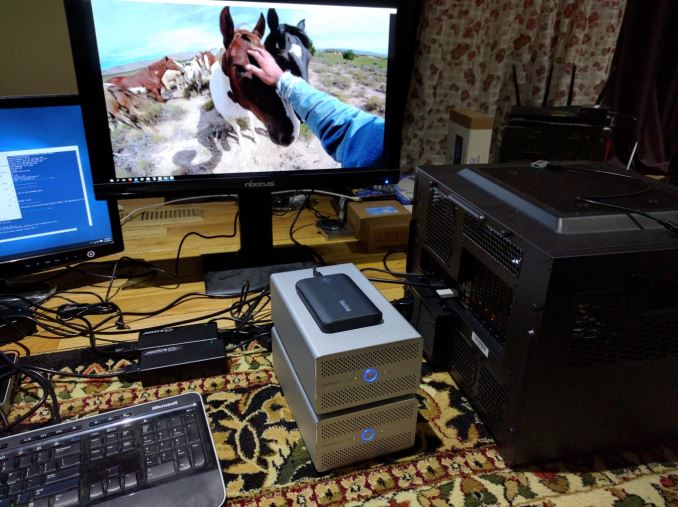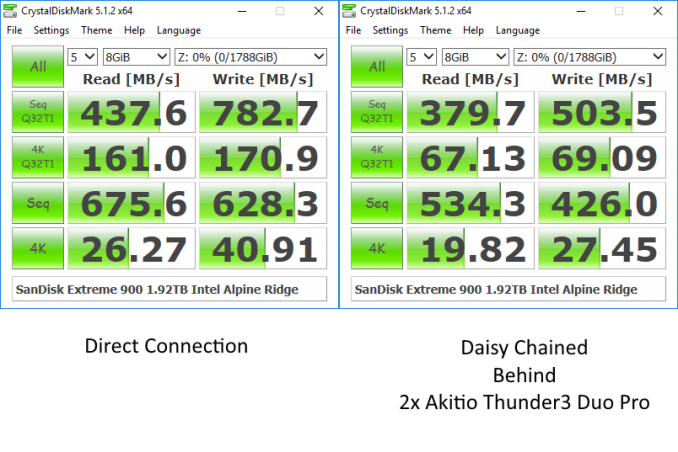Thunderbolt 3 in Action: Akitio Thunder3 Duo Pro DAS Review
by Ganesh T S on April 14, 2016 8:30 AM EST- Posted in
- Storage
- DAS
- Thunderbolt 3
- Akitio
Daisy Chaining
The full capabilities of Thunderbolt 3 are brought out when we have a series of devices hooked up in a daisy chain fashion to the testbed. Thunderbolt has always supported DisplayPort monitors at the end of a daisy chain. With Thunderbolt 3, any USB device with a Type-C interface can terminate the chain. The design of the Akitio Thunder3 Duo Pro ensures that a DisplayPort monitor does not need to be a link in the daisy chain, but can hang off as a node. We performed some testing with the following daisy chain configuration:
- AnandTech Skylake DAS Testbed with 2x Thunderbolt 3 (TB3) ports
- TB3 Port 1 of testbed connected to TB3 Port 1 of Akitio Thunder3 Duo Pro A
- TB3 Port 2 of Thunder3 Duo Pro A connected to TB3 Port 1 of Thunder3 Duo Pro B
- Nixeus Vue-27D 2560x1440 DisplayPort monitor connected to DisplayPort output of Thunder3 Duo Pro B
- SanDisk Extreme 900 1.92TB connected to TB3 Port 2 of Thunder3 Duo Pro B
The daisy chain setup is brought out in the photograph below.
IOMeter is one of the most reliable tools to measure performance while accessing multiple storage nodes simultaneously. In order to get maximum performance, we set up the two Akitio Thunder3 Duo Pro units in JBOD mode. Including the SanDisk Extreme 900, we ended up with five different physical disks that could be accessed over the single Thunderbolt 3 link. We ran the standard 128K sequential accesses with a queue depth of 4 and the 4K random accesses with a queue depth of 32. The table below shows the bandwidth realized as a function of the number of disks accessed simultaneously.
| 2x Akitio Thunder3 Duo Pro with 4x Intel SSD DC S3510 + SanDisk Extreme 900 (Thunderbolt 3 + USB 3.1 Gen 2 Daisy Chaining) IOMeter Benchmarks (MBps) |
||||
| Number of Simultaneous Disk Accesses | Write Bandwidth | Read Bandwidth | ||
| 128K Seq QD4 | 4K Rand QD32 | 128K Seq QD4 | 4K Rand QD32 | |
| 1 | 243.30 | 45.39 | 334.51 | 226.95 |
| 2 | 508.89 | 198.69 | 671.14 | 178.00 |
| 3 | 749.80 | 199.19 | 943.28 | 159.88 |
| 4 | 1010.37 | 160.12 | 1229.20 | 131.81 |
| 5 | 1489.72 | 172.68 | 1761.13 | 153.85 |
The sequential access numbers show that the link is nowhere near getting saturated despite pushing across more than 1700MBps (not accounting for the DisplayPort bandwidth here). However, with two bay devices supporting only SATA drives, it is difficult to sustain more traffic than what we have recorded here. That said, as more peripherals start coming out (in the form of docks or even units with 10+ drive bays), Thunderbolt 3 can show its true benefits.
Performance Implications
Daisy chaining is a nifty feature, but users must realize that as one goes further down the chain, the performance of the peripheral decreases. We studied this aspect further by using the SanDisk Extreme 900 USB 3.1 Gen 2 Portable SSD. In our first test, we connected the portable SSD directly to the Thunderbolt 3 port of the testbed. CrystalDiskMark was run with Alpine Ridge acting as a pure USB 3.1 Gen 2 host. In the second test, we connected the portable SSD to the free Thunderbolt 3 port on the Thunder3 Duo Pro that was farthest from the testbed (in the configuration mentioned at the top of this section).
The numbers clearly show a significant drop in performance as the peripheral gets further and further away from the main system. Similar drop in performance was noted for ATTO and all our real-life benchmarks (robocopy and PCMark 8 storage bench) also.












60 Comments
View All Comments
name99 - Thursday, April 14, 2016 - link
There is obviously a market for this sort of thing for SOME people, but if you're trying to save money, the way you do it is to use standard (high-performance) USB-3 cases and software RAID-1; there's no need to do that in the case.OSX and Linux obviously support RAID out of the box; I've no idea about Windows but I'd assume they're also on board. The only reason I can see that you need this hidden behind HW is if you need to move the device between different OS's.
danbob999 - Friday, April 15, 2016 - link
well there is this one for $50:http://www.newegg.com/Product/Product.aspx?Item=9S...
if you don't need a real case there are various dual dock for about $30. I also found dual 2.5" USB3 cases for $25.
Great_Scott - Thursday, April 14, 2016 - link
At $100 over the price of a normal enclosure, no one that really needs the extra features this offers will care. Thus the item will stay niche and the price will stay high.This is self-reinforcing problem.
TB is putting up a good fight, but the future doesn't look bright. No interface has ever survived higher prices by having better features. See: Microchannel, Token Ring, EISA, ATM, e-SATA and, yes, FireWire.
epobirs - Saturday, April 16, 2016 - link
Look at the Cineraid portable models. I picked up one from Newegg a couple of years ago for about $20 because the things weren't selling. Either the target market didn't know they existed or just didn't see the value. Mine still sits unpopulated because I don't have any great need for a somewhat faster USB 3.0 drive, unless I'm getting the drives really cheap. At the time I bought the unit I was getting a lot of requests for laptop SSD upgrades. The customers would either get their original hard put in an enclosure or just let me keep it for a token amount. (I'd label it and put it in a drawer for a month or so, in case the SSD proved defective.)I expected I'd have a couple of drives to use or sell it to somebody converting two laptops but neither situation came along since obtaining the Cineraid.
HideOut - Thursday, April 14, 2016 - link
The good news for us is that you will be asleep until hell freezes over. No more trolling from you.danbob999 - Thursday, April 14, 2016 - link
At $378 I might as well buy a PC... which will be able to hold at least 4 drives.jbrizz - Thursday, April 14, 2016 - link
People are going to plug these things into their Mac Pro, then do some 4k video editing on their 5k screen. You are not it's target audience (although you still shouldn't be so ignorant as to think that just because you don't want/need it no one else will).danbob999 - Thursday, April 14, 2016 - link
That's just one more reason why a Mac Pro is a crap PC. Such a professional PC should include room for at least 4 hard drives. Requiring an external $378 case just to get close to the same performance that you would get with internal drives is a joke.apoctwist - Friday, April 15, 2016 - link
I had to log into the site for the first time because of how silly this comment is. People working in the pro audio/pro video side are not going to rely on internal storage for their work or software RAID. First of all what happens when the machine you are using dies? What happens with your software RAID array on all those internal drives? With this device due to hardware RAID I can just plug in a cable on a new machine and I'm up and running in minutes. I don't have to worry about taking hard drives out of the PC, I don't have to worry about rebuilding the array (if that's even possible since you are using software RAID tied to you OS). All I have to worry about is a cable.That's why devices like these exist. In Pro video workflows external RAID arrays are common and encouraged. You see less heartache in the long run that way.
As an audio professional I have all of my projects/audio/recording on an external TB raid array. if my machine dies tomorrow I can pick up where I left off the next day. I also have multiple machines for DAW work and I can just plug my TB cable to them and continue working on whatever project I need to with no worries.
You are looking at a device like this from a consumer level but that's not what it's made for and the price tag is rather in line with what you will find out there for a TB enclosure.
theduckofdeath - Saturday, April 16, 2016 - link
It might sound like harsh words, but, he is right. At the moment,. everything Mac related is stupid solutions to problems we didn't have. Thunderbolt has to die. It's a way to milk consumers for even more money on relatively limited sales.There are a ton of ways to make a better solution for your external storage you actually need. The first choice is exactly what he said, design the workstation case to allow for stortage expansion, instead of selling people an overpriced and under-powered garbage bin.
There's a reason why companies like Oculus and HTC Vice refuse to support Mac OS these days. Because Mac devices are designed to work against the consumer from the foundation, Thunderbolt being one of the key culprits.